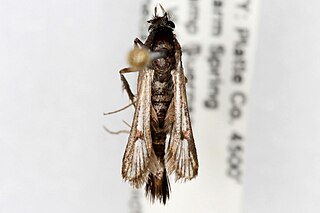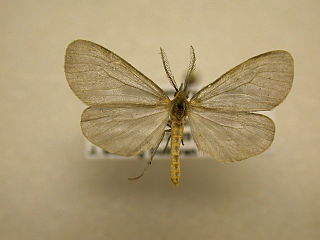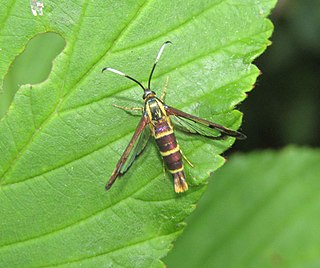
In ancient Roman religion and myth, Carmenta was a goddess of childbirth and prophecy, associated with technological innovation [citation needed] as well as the protection of mothers and children and a patron of midwives. She was also said to have invented the Latin alphabet.

The Sesiidae or clearwing moths are a diurnal moth family in the order Lepidoptera known for their Batesian mimicry in both appearance and behaviour of various Hymenoptera.

Carmenta is a genus of moths in the family Sesiidae.

The Hepialidae are a family of insects in the lepidopteran order. Moths of this family are often referred to as swift moths or ghost moths.

Orthonama obstipata, the gem, is a moth of the family Geometridae. The species was first described by Johan Christian Fabricius in 1794. It is common in continental Europe and adjacent lands, though in the northeast, its range does not significantly extend beyond the Baltic region and it is absent from northern Russia. This well-flying species is somewhat prone to vagrancy and able to cross considerable distances of open sea; it can thus be regularly found on the British Isles and even on Iceland.

Pagara is a monotypic moth genus in the family Erebidae. Its only species, Pagara simplex, the mouse-colored lichen moth, is found in North America, where it has been recorded from Alabama, Arkansas, Florida, Georgia, Illinois, Indiana, Iowa, Kansas, Kentucky, Maryland, Mississippi, New Hampshire, North Carolina, Ohio, Oklahoma, South Carolina and Tennessee. Both the genus and species were described by Francis Walker in 1856.
Carmenta anthracipennis, the liatris borer moth, is a moth of the family Sesiidae. It was described by Jean Baptiste Boisduval in 1875, and is known from the United States, including Florida, Texas, Massachusetts and Illinois.
Carmenta auritincta, the Arizona clearwing moth, is a moth of the family Sesiidae. It was described by Engelhardt in 1925. It is known from south-eastern Arizona and northern Mexico.

Carmenta bassiformis, the eupatorium borer moth, is a moth of the family Sesiidae. It was described by Francis Walker in 1856, and is found in the United States from Massachusetts to Florida, west to Wisconsin, Kansas and Texas.
Carmenta corni, the aster borer moth, is a moth of the family Sesiidae. It was described by Henry Edwards in 1881. It is known from North America, including Wisconsin.

Carmenta giliae is a moth of the family Sesiidae. It was described by Henry Edwards in 1881, and is found from western Alberta to north-western British Columbia, south to Arizona and New Mexico. The habitat consists of mid-to-high elevation montane meadows.
Carmenta subaerea is a moth of the family Sesiidae. It was described by Henry Edwards in 1883 and is known from the US state of Arizona.
Carmenta tecta, the mistletoe stem borer, is a moth of the family Sesiidae. It was described by Henry Edwards in 1882. It is known from the United States, including Arizona.
Carmenta texana, the Texana clearwing moth, is a moth of the family Sesiidae. It was described by Henry Edwards in 1881 and is known from the US states of Texas and Florida.

Carmenta verecunda is a moth of the family Sesiidae. It was described by Henry Edwards in 1881, and is known from the United States, including Colorado, Utah, California and Arizona.
Carmenta wellerae is a moth of the family Sesiidae. It was described by W. Donald Duckworth and Thomas Drake Eichlin in 1976. It is known from southern Arizona in the US and northern Mexico. The habitat consists of mountains and foothills.
Carmenta theobromae, the cocoa fruit borer, is a moth of the family Sesiidae. It was described by August Busck in 1910, and is known from Colombia and Venezuela.
Carmenta laurelae is a moth of the family Sesiidae. It was described by Larry N. Brown, Thomas D. Eichlin and J. Wendell Snow in 1985, and is known from the US state of Florida.
Eois carmenta is a moth in the family Geometridae first described by Herbert Druce in 1892. It is found in Guatemala.








